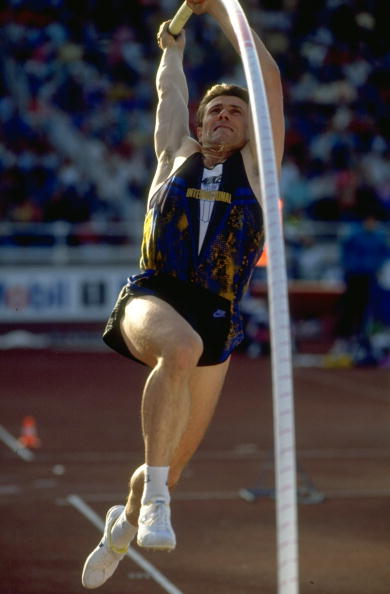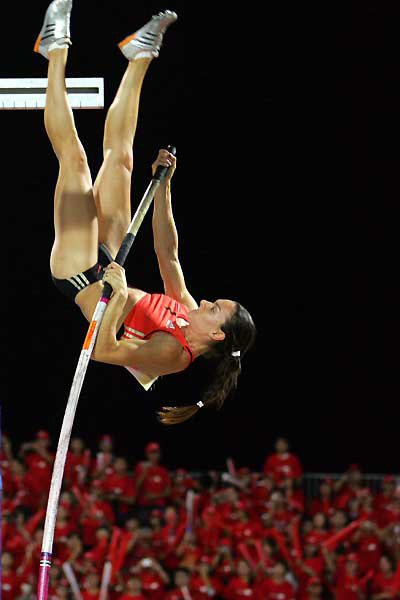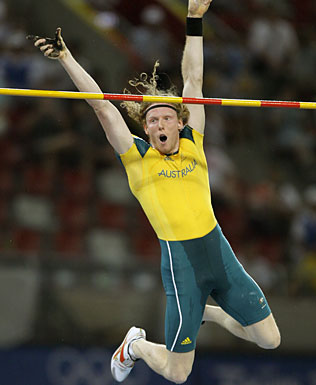Pole vaulting technique
Although there are many techniques used by vaulters to clear the bar, the generally accepted technical model can be broken down into several phases, listed and described below:
The approach

The approach consists of the vaulter sprinting down the runway in such a way as to achieve maximum speed and correct take-off position upon reaching the pit. The pole is usually carried upright to some degree at the beginning of the approach, then gradually lowered as the vaulter gets closer to the pit. By doing this the vaulter can use the potential energy stored from carrying the pole upright to his advantage. It is common for vaulters to use long, powerful strides at the beginning of the approach, then accelerate by increasing stride frequency while maintaining the same stride length while keeping their knees up like a sprinter. Unlike short sprinting events such as the 100 m in which a forward lean is used to accelerate, vaulters maintain a more upright torso position throughout the approach in order to maximise the height of their center of gravity at takeoff.
The plant and take-off

The plant and take off is initiated typically three steps out from the final step. Vaulters (usually) will count their steps backwards from their starting point to the box only counting the steps taken on the left foot (vice-versa for left-handers) except for the second step from the box, which is taken by the right foot. For example; a vaulter on a "ten count" (referring to the number of counted steps from the starting point to the box) would count backwards from ten, only counting the steps taken with the left foot, until the last three steps taken and both feet are counted as three, two, one. These last three steps are normally quicker than the previous strides and are referred to as the "turn-over". The goal of this phase is to efficiently translate the kinetic energy accumulated from the approach into potential energy stored by the elasticity of the pole, and to gain as much initial vertical height as possible by jumping off the ground. The plant starts with the vaulter raising his arms up from around the hips or mid-torso until they are fully outstretched above his head, with the right arm extended directly above the head and the left arm extended perpendicular to the pole (vice-versa for left-handed vaulters). At the same time, the vaulter is dropping the pole tip into the box. On the final step, the vaulter jumps off the trail leg which should always remain straight and then drives the front knee forward. As the pole slides into the back of the box the pole begins to bend and the vaulter continues up and forward, leaving the trail leg angled down and behind him.
The swing up

The swing and row simply consists of the vaulter swinging his trail leg forward and rowing, pushing, his top arm down to the hips, while trying to keep the trail leg straight, once in a "U" shape the left arm hugs the pole tight to efficiently use the recoil within the pole. Effectively, this causes a double pendulum motion, with the top of the pole moving forward and pivoting from the box, while the vaulter acts as a second pendulum pivoting from the right hand. This action results in even more potential energy being stored in the pole, all of which will be returned to the vaulter in later phases. The swing continues until the hips are above the head and the arms are pulling the pole close to the chest. From there the vaulter shoots his legs up over the cross bar while keeping the pole close.
Alternate swing methods
Another form of swing is called the double leg drop. After executing a normal take-off, the vaulter lets his lead leg drop and swings with both legs together. In doing this, the weight of the vaulter's lower body is centered further from his rotational axis, making it more difficult for the vaulter to swing with as great a speed as with a single legged swing. For the same reason, a vaulter with constant rotational speed will load the pole with more energy using a double legged swing than a single legged swing. Because the slower swing can make it more difficult for a vaulter to get in position for the rockback, the double leg drop is typically not taught as the conventional method. A successful double leg drop is exemplified by French vaulter Jean Galfione.
A third form of swing is called the tuck and shoot. This is accomplished by tucking both legs in toward the chest rather than leaving the trail leg extended. This has the opposite effect of the double leg drop: it shortens the lower body about the rotational axis, making the swing faster, but lessening the pole-loading effect of the swing. Because a shorter rotational axis can make it more difficult to use larger poles than with a longer axis, the tuck and shoot is also not considered the conventional method. A successful tuck and shoot is exemplified by former American record-holder Jeff Hartwig.
The extension
The extension refers to the extension of the hips upward with outstretched legs as the shoulders drive down, causing the vaulter to be positioned upside down. This position is often referred to as "inversion". While this phase is executed, the pole begins to recoil, propelling the vaulter quickly upward. The hands of the vaulter remain close to his body as they move from the shins back to the region around the hips and upper torso.
The turn

The turn is executed immediately after or even during the end of the rockback. As the name implies, the vaulter turns 180° toward the pole while extending the arms down past the head and shoulders. Typically the vaulter will begin to angle his body toward the bar as the turn is executed, although ideally the vaulter will remain as vertical as possible. A more accurate description of this phase of the vault may be "the spin" because the vaulter spins around an imaginary axis from head to toe.
The fly-away

This is often highly emphasized by spectators and novice vaulters, but it is arguably the easiest phase of the vault and is a result of proper execution of previous phases. This phase mainly consists of the vaulter pushing off of the pole and releasing it so it falls away from the bar and mats. As his body goes over and around the bar, the vaulter is facing the bar. Rotation of the body over the bar occurs naturally, and the vaulter's main concern is making sure that his arms, face and any other appendages do not knock the bar off as he goes over. The vaulter should land near the middle of the foam landing mats, or pits, face up.





